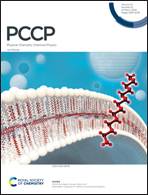DFT simulation of the X-ray diffraction pattern of aluminum-ion-intercalated graphite used as the cathode material of the aluminum-ion battery
Abstract
Many breakthroughs have been achieved in rechargeable aluminum-ion battery technologies in recent years. Most recently, operando X-ray diffraction (XRD) combined with density functional theory (DFT) calculations was reported to study the chloroaluminate anion (AlCl4−)-intercalated graphite cathode of the battery. However, there are quite a few discrepancies between the measured and simulated XRD patterns. This work is focused on the simulation of XRD patterns of graphite intercalation compounds (GICs) with DFT calculations. Our results reveal that both the geometry of AlCl4− in graphite and the gallery height of GICs are dependent on the intercalant density. At low intercalant density, the gallery height keeps constant, but at high intercalant densities, the gallery height is linearly related to the intercalant density. Our simulated XRD patterns are highly consistent with the measured operando XRD patterns. Not only do the angles of the peaks match very well, but also the relative intensities and the corresponding electrode capacities show reasonable agreement with the experimental results. The DFT simulation of the XRD pattern provides significant information on the stage index and the charge capacity of the GIC electrode.



 Please wait while we load your content...
Please wait while we load your content...
